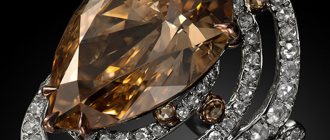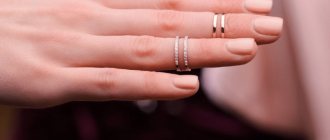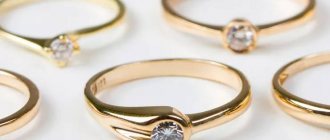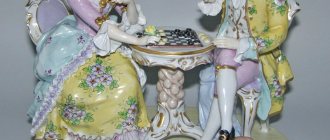Existing for more than six thousand years, rings appear in almost all cultures of the world. In addition to satisfying purely decorative needs, rings served a variety of purposes, both practical and symbolic. Rings were used to give one heart to another, to seal correspondence and to authenticate documents. They served to perpetuate friendship, honor the dead, and as talismans for protection against the forces of evil.
Rings were also used as symbolic expressions of faith or as tangible proof of power and wealth.
This small, perfect figure may seem like nothing on which to write an essay; and yet we will find it connected with history and poetry. It is a small link indeed, though it unites millions for better for worse, richer for the poor, more secure than shackles for a criminal. The impact of this may have made or lost a kingdom. It is made a symbol of power; and was a sign of slavery. Love placed it where the vein in the heart should vibrate. Love and friendship turned it into a memory; and he passed into the grave on the finger of his loved one.
Such a ubiquitous item, rings from all periods survive, providing valuable historical information about various cultures and as a timeline of major design themes and materials in the history of jewelry.
Similar articles
The history of necklace jewelry, from ancient times to the present day
History of Byzantine and chain mail jewelry, types, styles of change
Ancient and Classic Rings
The ancient Egyptians are known to have worn scarab rings, carved from a variety of stones such as lapis lazuli, amethyst, rock crystal and turquoise, strung simply with silver or gold wire. They were often engraved on the flat side of the scarab with decorative hieroglyphs, protective symbols or names; with a simple twist the functions of both the signet and the amulet were combined. During the New Kingdom period (1559-1085 BC), Egyptian goldsmiths progressed to casting all the metal stirrup-shaped bearing rings of the royal cartouche. These rings served not only as visible symbols of rank and power, but also as a means of verifying the authenticity of documents. The Egyptians wore rings as seals or for religious and talismanic purposes, and although the materials were carefully crafted and the pleasing arrangement of stones and designs evident, they were worn for a purpose rather than simply as decoration.
Ancient Egyptian ring. © Victoria and Albert Museum Collection
The ancient Greeks and Romans wore rings for a variety of purposes, including purely decorative ones. Scarab rings were worn by the Greeks, as were engraved rings engraved with nature motifs and figures from mythology and literature. There were bezels set with precious stones, prized for their beauty, rarity and talismanic properties, as well as simple gold rings. Rings can also be crafted in wire, filigree and intricate piercing work (opus interrasile).
In early Rome, during the Roman Republic, the first rings were made of iron and served as seals. The right to wear gold rings, jus annuli aurei
, was initially granted only to senators and only as ambassadors of the Republic. Over time, the right to wear gold rings was granted to all civilians. During the final years of the Roman Empire, men and women began to wear heavy gold rings set with rare and expensive gemstones, displaying increasingly visible displays of wealth and status. Although it was once rare to wear more than one ring, by the first century AD each finger could be laden with a variety of jewelry.
Roman Emerald Ring.
The Greeks used rings as signs of love and affection, often engraved with appropriate symbols such as images of Eros or Aphrodite. However, the custom of exchanging rings as betrothal tokens is believed to have originated with the Romans. Jewelry historian Diana Scarisbrick writes:
Since it was customary to exchange rings to signify the agreement of a business contract, the ring, annulus pronubu, was given as collateral for marriage, although, unlike betrothal rings of later periods, this did not mean that the union was forever binding. According to Pliny, this ring was originally made of iron without a precious stone, but by the 2nd century AD, everyone who could afford to use gold did so.
Roman wedding rings often depicted two right hands clasped in a symbolic representation of marriage and fidelity, called dextrarum iunctio
.
In Roman symbolism, the right hand was considered sacred to Fides
, the deity of fidelity—a motif that reappears in the Middle Ages as the federative ring.
According to ancient texts, the engagement ring is worn on the ring finger of the left hand, believing that this finger had veins, the hollow Amoris
, that flowed straight to the heart. Another motif used for wedding rings was the marriage knot or Hercules' knot, a simple and symbolic design of two intertwined ropes, which is probably the origin of the phrase "tying a knot."
Perhaps the style of ring most associated with the Romans was the signet ring. Diana Scarisbrick notes that Rome's wealth attracted the best and most skilled artists to engrave and set gemstones. Signet rings were used to stamp official documents, and gemstone engravings were often engraved with the wearer's portrait. They were also worn for purely decorative purposes and were often large and decorative. Aspects of everyday life, figures of gods and rulers, and portraits of poets and philosophers were among the popular themes. Love was another favorite theme, and intaglios depicting the heads of lovers face to face were used on signet rings as marriage rings.
Roman intaglio ring depicting two folded hands. © Victoria and Albert Museum Collection.
Rules for wearing rings
As with any other accessory, there are a number of principles for wearing rings on your fingers. Naturally, they do not require mandatory compliance, but a competent approach to the selection of rings will demonstrate your taste and ability to wear accessories. 1) catchy, bright rings, massive ornate rings (especially if it is not jewelry, but expensive jewelry) are not usually worn before 5 pm. 2) if you wear rings, and there are quite a lot of them, do not forget to monitor the condition of your hands. Any, even the most elegant piece of jewelry will look terrible on hands with peeling varnish and cracked skin. 3) Wearing several rings on one finger at once is considered bad manners, only if it is not a set of several almost identical rings that are worn together. Some tips:
- Oval, elongated rings look elegant and allow you to visually make your fingers longer and thinner.
- Women of small stature with short fingers should avoid massive rings.
- Ladies with thin and small fingers are better off choosing elegant, lightweight jewelry.
Middle Ages Rings
The ring was the most widely worn piece of jewelry for both men and women in the Middle Ages. Decorative and easily worn, hands were often heavily decorated with each finger, including the thumb, which was decorated with several rings at different knuckles. Rings were sometimes worn in other ways; suspended from a rope or ribbon, worn around the neck or tied around the arms, wound around a rosary or attached to a hat.
By the mid-1300s, the wearing of rings had become such a symbol of rank in Europe that laws of privilege were introduced in an attempt to regulate their wearing at appropriate class levels. Gold and silver rings with precious stones were to be reserved for royalty and nobility, while base metals such as pewter, gilded bronze and copper alloys, latten, were reserved for more natural origins.
Medieval turquoise ring. Jewelry Museum Pforzheim, Germany.
Decorative rings at this time were often made in the straight stirrup style, in which a simple band slopes down to a bezel containing a gemstone. Most gemstones were cut in cabochons until the fifteenth century, and their jagged contours were most easily set using a simple serrated claw or collet pressed against the gemstone.
Medieval sapphire ring. Jewelry Museum Pforzheim, Germany.
By the fifteenth century the settings became more elaborate and the stone is decorated with a scalloped rim. This scalloped design was sometimes referred to by the English as a "pans" in reference to its floral outline.4 The frame was often supported by more decorative arms, worked with designs such as scrolls, leaves, flowers and dragons, and decorated with niello and enamel. As for the gems themselves, they were chosen not only for their intrinsic value and beauty, but also for the talismanic properties they were thought to possess.
Direct contact of the stone with the skin was believed to enhance these medicinal or amuletic properties, and rings were particularly suitable in this aspect. Author Marian Campbell writes about some of these properties that medieval lapidaries attributed to certain gemstones, including:
... sapphires can banish envy, detect fraud and witchcraft. Rubies were believed to strengthen health, dispel bad thoughts, reconcile discord and fight lust. Emeralds were considered a cure for epilepsy, good for eye problems and increasing wealth. And turquoise is believed to protect against poisoning and prevent falls when riding. The diamond (which takes its name from the Greek Adamas, meaning invincible or unbridled) gave courage as well as protection from nightmares.
Medieval sapphire ring. © Victoria and Albert Museum Collection.
Surviving examples of medieval rings show that the most popular gemstones were sapphires, garnets, rubies, amethysts and rock crystal, and to a lesser extent diamonds.
Thirteenth century ring with previously used Roman intaglio in the third century AD. © Victoria and Albert Museum Collection.
Signet rings were widely used in the Middle Ages to authenticate messages, seal business documents and personal letters, and as signs identifying guilds and merchants. Intaglio engravings carved by ancient Roman and Greek craftsmen were especially prized and stimulated a revival of the hardstone craft. carving in the 13th century. The headband and hoops are often engraved with the wearer's name and various phrases in Latin or French.
The rounded capitals, known as the Lombard alphabet, were used until c. 1350 and from then until 1500 the lettering used in inscriptions was in the Gothic script style. A significant development in signet rings during this period was the use of heraldry as a distinctive design.
The earliest examples are thought to be Italian, but 15th-century heraldic tablets depicting coats of arms and other insignia were widely used by all who had the right to do so. A notable improvement was the foiled crystal sign, which featured a brightly colored crest underneath the engraved crystal, keeping the colors intact when pressed into the wax.
Early 14th century Jewish wedding ring. © Marie-Lan Nguyen.
The Middle Ages saw the rise of chivalry and courtly love. Friendship and love rings were popular and often marked with feelings of affection. A fashionable poetry ring was a gold hoop with a short poem "poetry" inscribed on the band in either Latin or, more typically, the French language of romance. Many of the phrases are repeated frequently, suggesting that the jewelers have taken inventory of the most popular phrases. Some favorite poems include mon cuer avez
(you have my heart),
duly mon couer
(with all my heart) and
amor vinicit omnia
(love conquers all).
Medieval ring of Posy. © Victoria and Albert Museum Collection.
More elaborate versions were decorated with simple enameled designs of leaves, flowers and tears that expressed tender emotions. Those with the means also used gemstones, especially if the ring was used as a symbol of marriage. Another popular sentiment ring during this era was the Jimmel ring. (from the Latin gemellus for twins) of intertwined double or triple hoops representing bonds of friendship and love. Believed to be of French origin, they were often combined with the federal motif of ancient Rome, which appeared as a marriage ring as early as the 12th century in England. Another marriage ring that was created during the Middle Ages was the Jewish marriage ring. These rings, most often made of richly enameled and filigree gold, were sometimes miniature miniature houses, symbolizing the marriage home or the Temple of Jerusalem. As such, they were reserved for symbolic use during the wedding ceremony, being too bulky to be worn on a daily basis.
Antique shops
To purchase antique items, it is better to go to a store that sells antiques. Employees of such stores often, in addition to being engaged in trade, also have a good understanding of the styles inherent in certain eras, and will be able to help make a choice and give practical advice. You should not neglect reviews of the store, and it is better to collect as much information as possible about the company that sells antique items.
Renaissance Rings
Portrait of a lady with jewelry and a high collar, ear hiding fashion. 1582, Germany. © Victoria and Albert Museum Collection.
The Renaissance was the age of the goldsmith. In contrast to the relative simplicity of the Middle Ages, goldsmithing during the Renaissance reached new levels of craftsmanship and design. As the arts of sculpture and painting reached new heights of excellence, the goldsmith's bench was considered the best training ground for achieving the depth of detail and precision that characterized the era's most accomplished artists. Truly established artists such as the painter and sculptor Donatello, the painter Botticelli and the sculptor and goldsmith Benvenuto Cellini were all trained as goldsmiths. This virtuosity was evident in all types of jewelry, but especially in the ring. Influenced by interest in sculpture and painting, rings were often decorated with arabesques. motifs with sculpted shoulders of figured and floral patterns and extravagantly enameled in increasingly sophisticated techniques, including en ronde bosse.
Renaissance Emerald Enamel Ring. © Museum of Decorative Arts, Paris.
The bezels were of a symmetrical quatrefoil or even layered floral design and were often chased and enameled. Along with more complex settings, another innovation was the hinged ring with compartments for scented materials or even furnishings. Perfume rings were especially useful in countering the daily olfactory assaults of this period (in another version they could also be used to conceal poisonous substances such as like the rings that the notorious borgies were reported to have used for such harmful effects). Colored stones remained popular among anyone who could afford them, and the most coveted stones were ruby, sapphire and emerald. Rings, as in the Middle Ages, were worn on each finger and on several joints. Late Renaissance haute couture included elaborate frills at the neck and large padded sleeves and cuffs that limited the shapes of jewelry that could be worn. Rings, on the other hand, were not encumbered by this fashion and could be used freely.
More decorative Renaissance rings featured portrait engravings of contemporary European rulers, such as Henry VIII of England. Roman emperors and other classical subjects were even more popular themes and gems, newly carved by skilled artists or preserved from ancient times, and highly prized in sculpted and enamelled settings. Heraldic seal rings of a more practical working nature tended to be mounted in simpler, more functional settings, which were valued as heirlooms representing a family's lineage and lineage.
Renaissance Table Cut Diamond Ring. © Walters Art Museum.
Bloodstone Renaissance Signet Ring.
Heliotrope was found to be a particularly suitable gemstone for this purpose. Rings depicting guilds or merchants were quite simple and suitable for intensive use. Initial rings were also popular and were more elaborately designed with initials tied in knots or forget me not flowers. In some cases they were given as wedding rings with the initials of the betrothed intertwined together.
Memento Mori Gimmel ring. Jewelry Museum Pforzheim, Germany.
Rings of love and friendship retained many of the same themes and forms as in the Middle Ages, albeit in more elaborate settings. Cupid with bow and arrows and hearts are two of the familiar motifs. More unusually, the deer ate dittany, an herb believed to heal wounds, including those caused by love's arrow. Diana Scarisbrick also writes about the loyal and faithful dog, adopted as a symbol of fidelity between lovers. The gift ring now had its own inscriptions, which were increasingly found in Roman capitals, hidden within the group and used as a token of love and as a wedding ring.
Renaissance Ring, c. 1550.
Gimmel rings, often decorated with a delicate motif, had lettering both inside and outside the bands, and more elaborate examples had three or more hoops that could accommodate longer lettering and more intricate designs. The more valuable gimelo ring features gemstones either in contrasting or uniform blocks of color and in rarer cases, a Memento Mori figure is secreted in compartments under the stones.
Reminders of impending mortality have long been a theme in jewelry, especially in rings. In the ancient world, symbols commonly used were skeletons, skulls and, most poetically, the figure of Cupid holding the symbolic torch of life upside down. Aphorisms referring to the transitory nature of life and its fleeting pleasures usually accompanied the images. The Middle Ages were filled with memento mori themes, with an emphasis on just and moral living while awaiting divine judgment. The Renaissance continued this tradition and rings were decorated with coffins, skeletons, hourglasses and most often skulls. During the Renaissance, mori souvenir themes were also used in signet rings, some with bands that rotated from recesses to the death's head, and wedding rings with both federation and souvenir motifs were found.
The most elaborate surviving example is a book-shaped medallion whose cover focuses on a skull and toads, recalling the biblical quote: “When a man dies, he will inherit creeping things, beasts and worms.” Inside, relevant Bible quotes are written on the back of the lid, above the sleeping child, hourglass and skull. 7
Drawing: Cornelis Anthonisz, 1537. Nascendo Morimur “When we are born, we die.” Rijksmuseum, NL.
Symbolism
As already mentioned, in the past, not everyone was allowed to wear rings on their fingers. Particular attention was paid to symbolism. Each people had their own beliefs and views on life. This influenced the formation of symbolism among various civilizations. However, each nationality has a thin thread that unites the idea of the existence of people all over the world. This can be discovered by observing how jewelry art developed at different times and in different territories.
Thus, the swastika is found in images of the most ancient peoples around the world. Before it was used by the Nazis to represent the Third Reich, it was a symbol of the rotating Sun, goodness and prosperity.
In the past, people used images of animals to identify themselves with the features, or, conversely, to endow themselves with the character inherent in this animal. The most popular were drawings of birds as a symbol of peace. According to legends, many peoples believed that birds participated in the creation of the world. The horse occupied an honorable place in symbolism and meant power and strength, the wolf symbolized strong-willed traits and spoke of the owner’s love of freedom.
Seventeenth century rings
By the end of the sixteenth century and the beginning of the seventeenth century there were noticeable changes in jewelry and ring styles. Just as the Renaissance period was marked by ornate gold jewelry, this era was characterized by a growing emphasis on the precious stone. Improvements in cutting and foiling techniques have led to a greater variety of shapes and an emphasis on showing off the beauty of the gemstones themselves.
Enamel is now typically only used as an accent in white or black, and while gold is still used for colored gemstones, diamonds stand out in silver. Large stones are now worn and set like solitaires while arrangements of smaller stones are set in a myriad of shapes, including stars, rosettes and crucifixes. The details on the shoulders are subdued and most often feature an engraved foliage motif simply enhanced with black and white enamel.
The prevalence of death was an integral part of everyday life in the 1700s. Ongoing epidemics, widespread poverty, famine and war—all of these Malthusian factors contributed to death becoming commonplace and souvenir rings
popular.
memento mori
themes including signets, wedding rings with a skull between the two hands, and medallion rings with skulls and crossbones. As with other rings, gemstones, when available, added an element of less formal design.
To the second half of the seventeenth century, Mori souvenir
the images began to merge with the mourning ring. Distributed according to wills, seventeenth-century mourning rings were decorated with details such as the person's name, initials, coat of arms and date of death. The characteristic feature was a plain gold band or gold band enameled in the form of emblems of death and burial, with an internal inscription. Strands of hair were sometimes contained in bezels or hollow hoops.
The growing popularity of bequests for mourning rings is generally attributed to the execution of King Charles I of England in 1649. Supporters of the monarchy wore jewelry, most often rings made of a flat-topped quartz crystal covering a gold wire cipher or crown set against a background of braided hair. This style known as Stuart Crystals would continue to be popular in the 18th century.
Memento Mori ring, 17th century. Skeleton holding an hourglass overcome by braided hair. Schmuckmuseum Pforzheim, Germany.
Prices
Prices for this jewelry masterpiece may vary depending on the size of the ring, its weight and the number of diamonds. The most common model, made of thin gold, costs about 34,000 rubles, a thicker masterpiece costs 105,000 rubles.
The price of a ring encrusted with stones starts from 140,000 to 650,000 rubles. Exclusive custom-made models number in the millions.
Now such a purchase can be made in many jewelry stores, here are the addresses of some of them:
- Moscow, Tverskaya street, building 15. Louvre store, phone: +7-495-629-16-15;
- Ekaterinburg, Sacco and Vanzetti street, building 74, first floor, phone: +7-343-215-60-00;
- Krasnodar, Industrialnaya street, building 2, phone: +7-861-213-47-76.
There are many online stores offering to purchase Cartier rings. Online stores have become an excellent alternative for people who are constantly busy with work and suffer from a catastrophic lack of time. In addition, they allow you to save money, because prices on the Internet are significantly lower than store prices.
But in the case of Cartier, this option does not work. The fact is that this jewelry legend is counterfeited more often than any jewelry in the world. Therefore, when purchasing online, the chance that you may purchase a fake instead of an exclusive product, and only discover it upon receipt, is very high.
The pricing policy of jewelry houses is that the cost of products in all countries and boutiques is almost the same, this also applies to online stores. If you are planning to purchase such a valuable and luxurious gift that will be passed on by inheritance and subsequently become a family heirloom, it is better to go to specialized stores to purchase it.
Eighteenth century rings
Georgian Giardenetti ring. © Victoria and Albert Museum Collection.
Georgian-era jewelry was light, elegant, and sophisticated. Showcasing the Rococo style, rings worn during the day often featured subtle combinations of colored stones, many in vibrant asymmetrical giardinetti bouquets or elegant ribbon and bow designs supported by gracefully parted shoulders.
As a nod to popular games, rings also represented the hands of enameled playing cards, fancy dress costumes, or even musical instruments.
Georgian citrine, rose diamond and enamel ring.
The more formalized neoclassical influences of the late 1800s saw the return of symmetrical settings and elongated bezels in a variety of shapes, including oval, overweight, diamond, and octagon.
These large frames often supported larger single stones surrounded by framing diamonds or pearls. Others were simpler, flanked by a pair of pink or diamond cut ones. The stones featured were often either semi-precious or paste-like, resulting in a luxurious appearance at a much more reasonable cost. It should be noted that paste jewelry was respected in its own right and was worn by the best jewelers of the time.
Silver Georgian ring with diamonds.
Stone settings have evolved from enclosing the bottom of the stone from the waist to a lighter, narrower setting. Tasseled bells, giving a more sophisticated and sophisticated look, were another innovation. More expensive pieces also paid attention to the lower part of the decoration, with ribbed detailing on the back, giving the piece a more polished and detailed appearance. While most gemstones are still plucked and moved back to enhance color and brilliance, a greater understanding of the mechanics of light dispersion has led to an open back, à jour parameters, on fine gemstones.
Rings are usually crafted in 18 or 22 karat gold, while sterling silver or silver topped gold is used for diamond settings. In many cases, the backs of silver diamonds were foiled and plated with an additional layer of gold to prevent tarnishing. Pinchbeck, a commonly used imitation gold of the time, was also used. Popular gemstones of the era, in addition to diamonds, included rubies, emeralds, sapphires, amethysts, garnets, pink topaz, turquoise and opal, as well as shells, corals and mother of pearl.
Georgian ancient deep ring. Museum of Decorative Arts.
Eighteenth-century neoclassicism, known as the Age of Enlightenment, has its roots in the traditions of ancient Greece and Rome. The desire for the classicism of the past was fueled in part by the tradition of sending the sons of the wealthy and well-connected on what became known as the "Grand Tour" of Europe.
Inspired by the artifacts of Rome and Greece, many began collecting antiquities, including intaglios and cameos inspired by or made in Ancient Greece and Rome.
Georgian Cameo Ring Hardstone.
Tassie Ring. © Victoria and Albert Museum Collection
Once again, signet rings became popular jewelry and revitalized the art of gem engraving, especially in Rome. A wide range of subjects, including details of ancient cities, sculpture, modern rulers, military heroes and popular authors, were chosen as subjects for the seals. Although there were always exceptions, the most common option was a simple oval or round frame in the spare elegant Roman style. Such was the need for these items and their value that copies of ancient engraved stones and stones became quite popular. The most famous and finely crafted of these were made in London by James Tussey. Made from a paste capable of imitating all sorts of colors and colors of the stone, over 15,000 reproductions of both modern and ancient gemstones were made. While some signet rings were still worn for practical purposes, the emphasis was now firmly on effect and style.
Romantic rings
Blue enamel heart with pearl c.1800.
The Georgian era, spanning the years between 1714 and 1830, was largely associated with the spirit of romance and the celebration of the bonds of friendship. The Fede and Dimel rings were still popular, as was the closely related Claddagh ring, which featured a single bezel of two clasped hands holding a heart surmounted by a crown.
The heart motif was by far the most popular symbol of love in this era, which included many other insignia such as lovers' knots, keys and locks, doves, burning torches, putti and levers. Hair was also a common element in many sense rings. The woven locks of a son, daughter, or grandson, as well as those of a wife or lover, were incorporated into rings in a variety of ways: woven into ciphers, hidden in glass compartments, woven into bezels, and combined with portrait miniatures.
In keeping with the more playful characteristics of the era, rings were considered, first introduced by the French firm Mellerio in 1809, which used the first letter of the gemstone to represent sentiments such as ADORE (Amethyst, Diamond, Opal, Ruby. Emerald). French was still the language of love, used in poetry rings and in visual and phonetic games in rebus rings that used pictures and words to express feeling. Pense de moi
(remember me) was represented by an enameled
pansy
followed by the letters
LACD,
which translate phonetically to
Elle a Cédé
(she yielded). After 1770, the style of extended bezels supported more complex tables that could combine several different symbols.
Marriage rings of this era ranged from simple gold or silver plated bands to the increasingly popular diamond ring. Often a pair of goalie rings, usually made of narrow diamond rings, would be worn on either side of the wedding ring. By the 1800s, the diamond had become the most common engagement ring; keepers have evolved into a simple wedding band, which is traditionally given during a wedding ceremony. The wedding ring was now traditionally worn on the ring finger of the left hand, and men also wore the ring.
Twin heart ring. Photo courtesy of Sotheby's.
In France, on a marriage ring known as an alliance
, the dates and initials of the couple were inscribed, and it was often accompanied
by a piece of the marriage
—a medal that also contained the couple's initials and the date of marriage. A favorite theme of the alliance was the romantic design of two hearts made of precious stones, sometimes pierced by Cupid's arrow or united under graceful giraffles. Another custom of the day was to give a ring with the bride's new code to mark the change of her name to that of her husband. Diana Scarisbrick notes:
It was also common for a bride to receive a ring at her wedding with the initials of her new married name, first set in pink diamonds in an open-set bezel, and in the second half of the century often intricately intertwined, set on a dark blue background8











